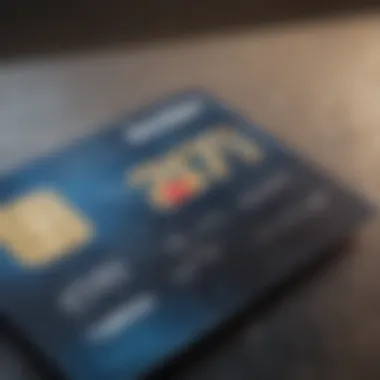A Comprehensive Guide to Fee-Free Prepaid Credit Cards


Intro
In today’s fast-paced world, managing one’s finances can often feel like juggling knives. That’s where prepaid credit cards come into play, particularly those that don’t hit you with monthly fees. These cards offer a sense of financial control; you can load them with a set amount, eliminating the risk of overspending. For many, free prepaid credit cards are akin to having a safety net in a debt-laden society. The right card can be a powerful tool for young professionals, families, and students seeking smarter ways to handle money without the burden of unnecessary charges.
This article will delve deeply into the nuances of these financial products, ensuring that you are well-armed with knowledge as you navigate through different options. We’ll dissect their functionalities, the perks and pitfalls, the application process, and associated costs. By the end of this exploration, you’ll know what's right for your unique financial landscape.
"Use prepaid cards wisely, and they can be your ally in the game of personal finance."
Overview of Financial Product
Definition
A prepaid credit card is essentially a reusable payment card that draws from a preloaded balance rather than a line of credit. Think of it as your own little budget on a card. You load money onto the card, and can only spend what you have on it. This differs from traditional credit cards, where you can rack up quite a debt, sometimes without even realizing it.
Key Features
- No credit check: Prepaid cards usually don’t involve credit checks, making them accessible to those who may not have built a credit history.
- Loadable funds: You can add money to these cards as you see fit, allowing for flexible budgeting.
- Wide acceptability: They work like regular credit or debit cards, accepted at numerous vendors worldwide, both online and in stores.
- No monthly fees: Many of them come with no monthly maintenance charges, making them a cost-effective option.
Purpose and Benefits
The prime purpose of prepaid credit cards with no monthly fees is to offer consumers a practical alternative to traditional banking and credit options. They’re particularly useful for:
- Budgeting: Since you can only spend what's loaded, it can help keep your finances in check.
- Traveling: Prepaid cards can provide a safer alternative to cash when traveling abroad.
- Educational use: Students can use them for spending without the temptation of racking up debt.
- Gifts: They’re solid options for gift-giving, letting the recipient choose how they want to spend.
Types and Categories
Understanding the various types of prepaid credit cards can help you make an informed choice. Here’s a breakdown:
Types of Prepaid Credit Cards
- General Purpose Reloadable Cards: These cards can be reloaded with funds repeatedly.
- Gift Cards: Preloaded with a fixed amount, they can’t typically be reloaded.
- Payroll Cards: Employers can directly deposit wages onto these cards for employees without bank accounts.
Pros and Cons
Pros
- Easy to obtain
- Helps with budgeting
- Safe travel option
Cons
- Limited features compared to traditional credit cards
- Possible transaction fees in certain cases
Situational Uses
- For Students: Managing a budget for groceries or basic expenses without incurring credit card debt.
- For Young Professionals: A way to separate business expenses while keeping personal finances intact.
- For Families: Teaching kids about budgeting with a supervised spending card.
Application Process
Applying for a prepaid card is typically straightforward, but being informed can save you time. Here's how it usually goes:
Steps to Apply
- Select the Card: Compare different cards for their features and fees.
- Visit the Provider’s Website: Start the application online or visit a retail location.
- Fill Out the Application: Provide necessary information like your name, address, and contact details.
Eligibility Requirements
- Generally, you must be at least 18 years old, but some cards can be acquired by minors with parental consent.
Documentation Needed
- A government-issued ID (like a passport or driver’s license)
- Proof of residency (like a utility bill)
Common Mistakes to Avoid
- Not reading the terms and conditions thoroughly which can lead to unexpected fees.
- Loading more money than you initially planned.
Tips for Success
- Shop around for the best offers
- Set a loading schedule that aligns with your earning cycle
Costs and Fees


Though many prepaid cards tout having no monthly fees, understanding all associated costs is crucial.
Types of Fees Associated
- Load Fees: Some cards may charge a fee for adding funds.
- Transaction Fees: Look for cards that offer free transactions as much as possible.
Comparisons of Costs Across Options
Consider making a budget plan that factors in potential fees associated with different cards. This can help you determine what card ultimately offers you the best value.
In closing, while free prepaid credit cards can be a boon for budgeting and money management, being informed about your options can make a world of difference. Stay tuned as we dive even deeper into maximizing your prepaid card's utility in the next sections.
Understanding Prepaid Credit Cards
When it comes to managing personal finance, understanding the mechanics of prepaid credit cards is crucial. Often, these cards are overlooked by young professionals, families, and students alike. However, grasping the significance of prepaid cards lays a solid foundation for navigating the often murky waters of personal finance in today’s cashless society. The primary advantage here is that they encourage disciplined spending, allowing users to only spend the money they have deposited.
Prepaid cards offer a layer of security. Unlike traditional bank accounts, there's no risk of overdraft fees since you can’t withdraw more than you load onto the card. This feature suits individuals who want to avoid debt traps or who may have trouble keeping their spending in check. Also, for those current on their budgets, loaded prepaid cards can supplement everyday purchases without the temptation of falling into credit card debt.
That's not all; these cards are also quite flexible. Users don’t need to involve credit checks for applications, which greatly expands access. In an age where financial management tools are needed more than ever, prepaid credit cards stand as an accessible option.
Basics of Prepaid Credit Cards
Prepaid credit cards are a type of payment card that requires users to preload funds before they make any transactions. This process is akin to adding money to a digital wallet. Unlike traditional credit cards connected to a line of credit, where users borrow from the bank, prepaid cards only allow spending up to the amount already deposited. For many, particularly those just starting out in their financial journeys, this can simplify spending discipline.
Common features include:
- Reloadable: Most prepaid cards can be reloaded as needed, which makes them convenient for continued use.
- No Monthly Fees: Many options exist in the market that do not charge monthly maintenance fees, making them appealing for budget-conscious consumers.
- Widely Accepted: Prepaid credit cards are typically accepted anywhere traditional credit and debit cards are used, making them versatile in everyday transactions.
Comparison with Traditional Credit Cards
When you put a prepaid credit card side by side with a traditional credit card, the differences become glaringly obvious. A typical credit card allows you to borrow specific amounts from a financial institution. This can be beneficial if you’re aiming to build your credit score, but it also comes with risks, such as accruing debt and incurring interest charges. On the other hand, prepaid cards operate independently of credit transactions.
Here’s a brief rundown of key distinctions:
- Spending Limit: Prepaid cards can only utilize funds that have already been loaded, while credit cards can incur debt beyond the account holder’s existing balance.
- Impact on Credit Score: Using a traditional credit card influences your credit score, because your spending habits contribute to your credit utilization ratio. Prepaid cards have no effect, which can be a pro or con, depending on your financial goals.
- Interest Rates and Fees: With traditional credit cards, one often faces interest rates and various fees; prepaid cards typically come with fewer hidden costs.
"In personal finance, knowledge isn't just power; it's the key to smart decision-making."
As we progress deeper into the topic, let’s explore how these prepaid options further align with modern financial practices and consumer needs.
Defining Free Prepaid Credit Cards
In the nuanced landscape of personal finance, the concept of free prepaid credit cards emerges as a significant contender. These cards offer a straightforward payment method without the hidden costs often encountered in traditional credit options. For many, especially young professionals, families, and students, navigating financial products can be daunting. Understanding what constitutes a free prepaid credit card is essential for making savvy financial decisions.
Free prepaid credit cards typically don’t come with monthly fees or minimum balance requirements. This is where their appeal lies. Individuals can use these cards to manage their spending effectively without incurring nagging charges month after month. They are especially useful for those who prefer to avoid the pitfalls of debt accumulation commonly associated with traditional credit cards.
The notion of being 'free' is significant here, as it allows users to engage in transactions without worrying about additional costs diminishing their financial buffer. Yet, the term can be a bit of a double-edged sword; understanding the underlying criteria and potential fees associated with these cards is crucial to grasp what free genuinely means in this context.
Criteria for 'Free' Prepaid Cards
When delving into free prepaid cards, it’s important to identify the criteria that set them apart from paid options. Here are a few things to consider:
- No Monthly Fees: As the term suggests, the card must not charge any monthly maintenance fees.
- Cost-Free Reloading: Many cards allow you to add funds without additional charges. Some providers even offer reloads through direct deposit at no cost.
- Broadly Accepted: A good prepaid card should work at a wide range of merchants, both online and in brick-and-mortar stores.
It's worth keeping an eye on the fine print. A card may be marketed as free but could have fees for specific services, such as ATM withdrawals or foreign transactions.
Analysis of Monthly Fees and Charges
Despite being labeled as "free," many prepaid cards have a tendency to slide in various expenses that could surprise users down the line. The analysis of these fees is where the rubber meets the road when it comes to understanding the real utility of choosing a free prepaid credit card.
- Common Charges: Look out for reload fees, international transaction charges, or ATM withdrawal costs.
- Inactivity Fees: Accounts that see little action for a set period might incur a charge, which is typically assessed monthly.
- Cost of Adding Funds: Understand the different methods of reloading your card, whether through bank transfer, third-party services, or cash at retailers, and any associated fees.
"Not all prepaid cards are created equal. Scrutinizing monthly fees and so-called free services can make a world of difference in your finances."
The importance of thoroughly assessing the monthly fees and charges can't be understated. Knowing what you're up against not only saves money but also enhances your overall experience with prepaid cards, making them a valuable tool in your financial toolkit.
Benefits of Using Free Prepaid Credit Cards
When it comes to managing finances, free prepaid credit cards offer a variety of advantages that can enhance your monetary strategies. First and foremost, these cards are remarkable tools for budgeting and financial discipline. Young professionals and families often juggle several financial responsibilities, making it essential to keep spending in check. Free prepaid cards provide a clear limit on expenses, allowing users to load only a specific amount. This helps curb overspending and encourages more deliberate spending habits.
Additionally, the accessibility of free prepaid credit cards means they cater to a broad audience, including those with less-than-perfect credit histories. Traditional credit cards often get mired in lengthy approval processes with stringent credit checks. In contrast, free prepaid cards usually require minimal qualification, making them a viable option for students or individuals new to adulting. This inclusivity breaks down barriers, enabling more people to participate in the financial system.
Safety is another cornerstone found in the benefits of these cards. As online shopping takes hold, concerns over fraud and identity theft have surged. Free prepaid credit cards come equipped with heightened safety features, adding layers of protection against unauthorized transactions. Being able to only spend the money loaded onto the card insulates users from incurring debt due to unauthorized charges, which is a crucial consideration in today’s digital marketplace.


With these key aspects in mind, let's delve deeper into the specific benefits that free prepaid credit cards provide.
Potential Drawbacks of Free Prepaid Credit Cards
When it comes to free prepaid credit cards, it’s easy to get swept away by their appealing features and the absence of monthly fees. However, it’s crucial for users to be aware of some potential drawbacks. These drawbacks can affect overall satisfaction and utility. Knowing these limits can help young professionals, families, and students navigate their financial landscape more effectively.
Limitations on Spending and Reloading
One of the significant downsides of prepaid credit cards is their limitations in spending and reloading. These cards often come pre-loaded with a set amount of money, which means once the balance hits zero, users must know how to replenish it.
For instance, consider a scenario where someone depends solely on a prepaid card for daily expenses. They go to the grocery store and find themselves in a pinch because they forgotten their reload schedule. In such a case, being unable to just swipe indefinitely can become cumbersome. Also, reloading methods may vary significantly among providers. Some may charge fees for adding funds, while others might have restrictions on how much you can load at a time. Understanding the reload limits and associated costs is essential to avoid unexpected hurdles.
Incompatibility with Certain Transactions
Another consideration is that some prepaid cards may not work seamlessly with all transactions. Though they are gaining popularity, certain service providers or platforms might not accept them. For example, you might find it difficult to pay for subscriptions like Netflix or regular services that prefer standard credit cards.
It’s important to know that certain types of transactions, such as hotel reservations or car rentals, may require a credit card with the ability to create a hold for funds. When using a prepaid card, you could be left stranded if the establishment does not accept it. Doing a little research on where your card will be accepted can save you from chaos down the line.
Customer Service Concerns
Lastly, customer service can be a tricky area with prepaid credit cards. Many prepaid card providers tend to operate online, and that can sometimes lead to long wait times for support. Imagine needing urgent assistance about a transaction issue only to be met with an impersonal chat or email response that takes days to resolve.
If the prepaid card fails or there’s a discrepancy in your balance, getting help can feel like pulling teeth. Look for providers that offer robust support options, including phone assistance if that’s your preference. Customer service is critical in these situations, making it key to consider as you choose your prepaid card.
Despite the allure of fee-free financial tools, exploring their potential downsides ensures you're making a well-considered decision.
By weighing these aspects carefully, users can navigate the potential pitfalls associated with free prepaid credit cards and utilize them to improve their financial strategies.
How to Obtain a Free Prepaid Credit Card
Knowing how to obtain a free prepaid credit card is crucial in today’s financial landscape. They serve as practical tools for budgeting and spending without straining your finances. With so many options available, understanding the steps and requirements to access these cards can put you in a better position to manage your money wisely. This section illustrates the important elements you need to consider, along with a clear path towards acquiring your own prepaid card.
Eligibility Requirements
Before diving into the application whirlpool, it’s essential to know the eligibility requirements for obtaining a free prepaid credit card. Generally, the main factors include:
- Age: Most companies require you to be at least 18 years old. Some may even allow those under 18, but usually need parental consent.
- Identification: A government-issued ID or a Social Security Number is often necessary to verify your identity.
- Residence: Many providers restrict their services to certain geographical areas, so being a resident in the specified locations is important.
- Credit History: Unlike traditional credit cards, prepaid options usually don't check your credit. However, some providers may request your financial history if additional services are tied to the card.
These requirements can vary widely between providers, so it is wise to read the fine print before proceeding.
Step-by-Step Application Process
Once you meet eligibility criteria, applying for a free prepaid credit card is a straightforward process. Here’s a step-by-step guide:
- Research Providers: Begin with a thorough comparison of various providers. Look into features, fees, and any caps on spending or reloading. Targets like Green Dot, NetSpend, and Bluebird are good places to start.
- Gather Necessary Documents: Collect any documents required such as your ID, proof of residence, and Social Security number.
- Select the Card: Choose the prepaid card that best suits your financial needs. Make sure it aligns with your spending habits and any potential fees.
- Fill Out the Application: Most applications are available online. Simply provide the needed information, and double-check it for accuracy.
- Await Approval: After submission, approval can be instantaneous or take a few days, depending on the provider.
- Receive Card: Once approved, your card will be mailed to your specified address. Some providers might allow you to access a virtual card immediately.
Understanding Activation and Usage
After you receive your free prepaid credit card, the next crucial step is activating it.
- Activation Process: Typically, this involves calling a designated number or visiting a provider’s website where you’ll enter your card details.
- Loading Funds: You can load funds through direct deposit, bank transfer, or via cash reload at authorized locations. Make sure to understand the available methods and potential fees associated with them.
- Using Your Card: Your card acts like a debit card, meaning you can use it for purchases until the balance runs out. Keep an eye on your spending to avoid hitting a zero balance unexpectedly.
Ironing out these details ensures you are well-equipped for effective usage. Remember, keeping tabs on your balance is vital to maintain control over your finances.
Top Providers of Free Prepaid Credit Cards
When diving into the rabbit hole of prepaid credit cards, understanding who the top players are is like knowing the key ingredients of a good recipe. Free prepaid credit cards, especially the ones without monthly fees, come in different flavors from various providers. A savvy choice can help you avoid unnecessary costs while maximizing the benefits.
These providers often compete to offer features that cater to diverse users. It's essential to know what sets them apart, as the right fit can enhance your overall financial management. In this section, we’ll explore what makes each provider tick and what you should consider when selecting a prepaid card.
Features of Leading Providers
Each prepaid card provider brings a unique set of features to the table. Understanding these can help you pinpoint the card that best suits your life.
- Low or No Fees: Top providers usually boast competitive fee structures. Look for options that not only avoid monthly charges but also minimize transaction and reloading fees.
- Mobile App Functionality: In today’s digital age, an intuitive mobile application can make a world of difference. Leap into a card that offers easy-to-use features for tracking spending, reloading funds, and managing accounts.
- Rewards Programs: Some providers incentivize usage. Rewards might include cash back on purchases or points that can be redeemed for gift cards or other perks.
- ATM Access: Make sure your chosen card offers wide access to ATMs without exorbitant fees. This is vital for cash withdrawals when needed.
- User Support: Having approachable customer service can alleviate headaches. Look for cards that provide solid support channels, whether it’s via chat, phone, or email.
"Picking the right provider is key, as it greatly influences your prepaid card experience."
Comparative Analysis of Card Offerings
When comparing different prepaid credit cards, there are a few angles to consider that may not be the first ones that spring to mind.


- Annual Limits vs. Flexibility: Some providers impose annual spending limits, which could pose challenges if your spending habits vary. Evaluate how flexible a provider is with their limits and whether they match your lifestyle needs.
- Reload Options: Look at how you can add funds to your card. Some providers offer diverse reload options like direct deposit, bank transfers, or cash reloading at various retail locations. Checking the options available can make your life a lot easier.
- Funding Speed: Not all providers operate on the same timeline. Review how quickly funds become available once loaded. If speed is of the essence, find a card with quick processing times.
- Integration with Other Financial Tools: Does the card work well with budgeting apps or personal finance software? Sometimes, integration can streamline your financial management significantly.
- User Reviews and Experiences: Don’t neglect what actual users say. Online forums or platforms like Reddit can provide authentic insights into how each provider stacks up in the real world.
Choosing the right prepaid credit card is not just about avoiding fees; it’s about finding a match for your financial habits and ambitions. By weighing the features and offerings against your specific needs, you’re more likely to find a card that will serve you well.
Tips for Maximizing the Value of Prepaid Cards
Using prepaid cards can be a great way to manage finances if done properly. This section highlights various strategies that can help individuals get the most out of their prepaid cards. Understanding how to effectively use these cards not only saves money but also enhances the overall financial experience.
Managing Reloads Effectively
Reloading a prepaid card might seem straightforward, but there are nuances to consider. Each provider may offer different methods, including bank transfer, direct deposit, or cash reload at retail locations. To avoid unnecessary fees, it is essential to choose the most cost-effective reload option that works for your lifestyle. For instance, some services charge for reloading cash at grocery stores, while others have partnerships with specific retailers for free reloads.
Tip: Set a schedule for reloading your card. This helps ensure that you maintain sufficient funds without overspending or incurring additional fees.
Monitoring Transactions and Balances
Keeping an eye on transactions can feel tedious, but it’s crucial for avoiding pitfalls. Utilize mobile apps or online platforms provided by the card issuer to regularly check your balance and transaction history. This practice not only helps prevent overspending but also allows for quicker detection of unauthorized activities. Understanding where your money goes can guide future spending decisions.
Some practical steps to monitor effectively:
- Set Alerts: Turn on transaction alerts to receive notifications whenever your balance hits a certain threshold.
- Review Monthly Statements: Even if the card doesn’t charge a fee, reviewing statements can reveal unexpected charges.
Avoiding Common Pitfalls
Even seasoned users can sometimes trip over a few common missteps when using prepaid cards. One significant issue is assuming that a prepaid card functions exactly like a credit card. For example, many prepaid cards do not offer overdraft protection. If you spend beyond what’s loaded, transactions may simply decline, leading to inconvenience during a purchase.
Here are some pitfalls to watch out for:
- Not Reading the Fine Print: Each card has different terms about fees and limitations. Ignoring the fine print can lead to unwelcome surprises.
- Neglecting Expiration Dates: Some prepaid cards may have expiration dates. Keeping track of this ensures you can utilize funds before they are lost.
- Underestimating Withdrawal Limits: Many cards limit ATM withdrawals. Familiarize yourself with these limits to avoid withdrawal outages when needed.
By focusing on these strategies, users can considerably improve their experience with prepaid cards while keeping control of their finances.
Alternatives to Prepaid Credit Cards
Exploring options beyond prepaid credit cards is essential in today’s financial landscape. Many individuals might find that while prepaid cards offer specific benefits, alternatives can provide enhanced flexibility and features that cater to diverse financial needs. It's all about picking the right financial tool that fits one's lifestyle, and understanding these options is key.
Other Types of Payment Cards
When considering other payment card types, several choices spring to mind:
- Debit Cards: Connected directly to your checking account, debit cards allow for seamless spending without the risk of overspending. Unlike prepaid cards, you draw from your actual funds, which can help maintain healthy spending habits.
- Credit Cards: Offering a line of credit, these cards can improve your credit score if managed well. Unlike prepaid options, credit cards allow you to build credit history, which is vital for future loans or mortgages.
- Secured Credit Cards: For those with limited or poor credit history, secured cards require a cash deposit that acts as collateral. This can be a stepping stone to obtaining better credit products.
- Charge Cards: These cards don’t have a preset spending limit, though they must be paid in full each month. They often come with rewards and benefits that are appealing to frequent travelers or those who spend heavily.
Each of these card types has its nuances. For instance, many debit and credit cards offer rewards programs, while prepaid cards are straightforward without such frills.
Evaluating Personal Finance Apps
The rise of personal finance apps has transformed how people manage their money. These tools allow users to track spending, set budgets, and even link to various bank accounts. Some key benefits include:
- Budgeting Capabilities: Financial apps aid in visualizing where your money goes each month. This information can help steer you towards better spending habits.
- Expense Tracking: With automatic categorization, these apps let you keep an eye on specific expenses. This can help if you are wondering why your budget seems to be running dry too quickly.
- Alerts and Notifications: Many apps notify users of unusual spending or upcoming bills, helping to avoid late fees.
- Integration with Various Accounts: In a world where people may wander between multiple accounts and financial products, connectivity is vital. Personal finance apps often track transactions across different platforms.
Working within personal finance apps alongside alternative payment cards creates a comprehensive financial ecosystem for users. It’s akin to blending the best of both worlds to achieve financial awareness and stability.
"Making informed decisions about financial products can greatly enhance individual financial wellness."
Future Trends in Prepaid Credit Cards
As the landscape of finance continues to evolve, prepaid credit cards are no exception to the wave of change brought about by technology and consumer preferences. Understanding the future trends in prepaid credit cards is crucial, especially as more individuals seek flexibility and control in their financial dealings. These cards are becoming increasingly popular due to their lack of monthly fees, making them an attractive option for a diverse range of users, from young professionals trying to manage their budgets to families looking for secure alternatives.
Technological Advancements
The prepaid credit card sector is witnessing remarkable innovations thanks to technology. Features like mobile wallets and app integrations are gaining traction, allowing users to manage their funds right at their fingertips. For instance, many providers now offer real-time tracking of expenditures through their mobile apps, giving users an updated view of their financial status. This not only improves transparency but also empowers users to make informed spending choices.
Furthermore, contactless payments are revolutionizing the way people interact with their prepaid cards. Just a tap and you're done, streamlining the payment process and making it easier for users to make transactions in crowded places without fumbling for cash or waiting in long lines. As technology advances, we can expect to see even more security enhancements, such as biometric authentication, making prepaid cards even safer.
"The advent of technology is reshaping how prepaid credit cards are perceived and used, offering unprecedented convenience and security."
Blockchain technology is another area poised to impact the future of prepaid cards. As more companies experiment with blockchain to streamline transactions, we might see a future where prepaid cards operate on decentralized systems, allowing for faster and more secure transactions.
Market Growth Insights
Looking forward, the prepaid credit card market shows promising growth potential. As consumers become more financially savvy, the demand for flexible payment options is increasing. This growth isn't just about the product; it's also about raising awareness and understanding of how these cards work.
Market research indicates a shift in demographics utilizing prepaid cards. Traditionally, they catered mostly to individuals without access to traditional banking systems. However, now, millennials and Gen Z are entering the scene, recognizing the value of having greater control over their budget without the burden of overspending that can accompany credit cards.
Some critical factors contributing to the growth include:
- Increased adoption of e-commerce and mobile shopping, where prepaid cards offer a hassle-free payment method.
- Greater financial literacy efforts leading consumers to understand the importance of avoiding debt.
- Partnerships between prepaid card providers and businesses, enhancing utility and integration in day-to-day financial transactions.
As these trends unfold, the market is likely to attract various new entrants, including fintech startups, eager to cater to the evolving needs of consumers and challenge established players in the industry. Observing these trends will be essential for anyone looking to navigate the future of prepaid credit cards effectively.



